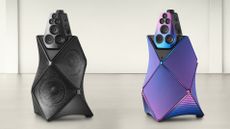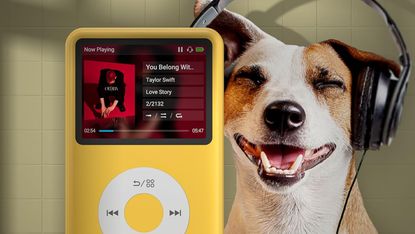Audio
The latest Audio breaking news, comment, reviews and features from the experts at T3
Explore Audio
-

Samsung’s new elite Wi-Fi speakers are something spatial
Can be used standalone or part of a Q-Symphony setup with your Samsung TV
By Carrie Marshall Published
-

IKEA's new retro-style speaker is '5-star' rated – and very affordable
It's certainly 'NATTBAD', it's very good indeed!
By Mike Lowe Published
-

This vinyl deck is also a CD player – with a cunning, hidden transport inside
This is what you get when the CD resurgence clashes with the vinyl revolution
By Chris Hall Published
-

This elite CD player is a top-class transport of delight
Shanling unveils its most advanced CD transport yet with dedicated upsampling to make your discs sound better
By Carrie Marshall Published
-

FiiO's CD quality digital audio player invokes the spirit of iPod nano for an unbelievable price
This may be its most attractive audio player yet – including its cost
By Carrie Marshall Published
-

Want a new Bluetooth speaker for Christmas? The 3 best for all budgets
Festive fun for your ears – at budget, middle and luxury price points
By Mike Lowe Published
-

New premium phono stage ditches the mains in favour of 20 batteries
This battery-powered phono from Genesis Advanced Technologies promises five-figure performance for a four-figure price
By Carrie Marshall Published
-

I've been playing around with this hidden Sonos feature, and I still think it's a sleeper hit
It's niche, but if you can use TV Audio Swap you're in for a treat
By Max Freeman-Mills Published
-

Beats turns a 2011 Travis Scott tweet into its most personal campaign yet
Dare To Dream revisits the rapper’s early ambitions while spotlighting Beats’ latest performance earbuds
By Matt Kollat Published
-

Dali's new speaker range offers Sonik perfection – and it's more affordable than you'd think
There's something for everyone in this range of hi-fi speakers
By Sam Cross Published
-

What is Dolby Atmos FlexConnect? The latest 3D audio standard explained
FlexConnect allows for versatile speaker placement – en masse, if you wish
By Mike Lowe Published
-

IKEA’s Bang & Olufsen-alike speakers are now available to buy – here's how much they cost
Each version is available to buy now from IKEA’s online store
By Lizzie Wilmot Published
-

Apple has managed to turn my favourite Sci-Fi idea into a reality
Apple's Ron Huang and Areeba Kamal explain how live translation has given the AirPods superpowers
By Mat Gallagher Last updated
-

This new CD Player puts your old Sony Walkman to shame
The Pro-Ject CD Box RS2 Tube is a CD player for the most discerning of audiophiles
By Sam Cross Published
-

These over-ear headphones bring MEMS and Planar Magnetic drivers together – could this be audiophile heaven?
UM's first full-sized headphones combine MEMS and Planars to deliver the strengths of both technologies
By Carrie Marshall Published
-

Buying new earbuds this Christmas? Here are 3 of the best – for all budgets
Choosing wireless earbuds doesn't have to be difficult
By David Nield Published
-

I've tested the Pixel Buds 2a and there's one thing I miss from the Buds Pro
Save cash with Pixel Buds 2a if you're happy to forego this feature
By Chris Hall Published
-

I've tested the new Echo speakers, but there's one thing we need to talk about
One of the stars of the Echo line-up is no more
By Chris Hall Published
-

Want a vinyl player for Christmas? The 3 best Bluetooth record players for all budgets
Pitching three of the best BT turntables head-to-head in this festive face-off
By Simon Lucas Published
-

This small box from Sweden turns any speaker into a smart speaker for less than you'd think
Turn any speaker into an Amazon Echo rival with the Atonemo Streamplayer
By Sam Cross Published
-

The Marshall Kilburn III is my top Bluetooth speaker and not because of the sound quality
It's an example of what happens when form and function collide
By Chris Hall Published
-

This high-spec headphone amp punches way above its price tag
The FiiO K15 has a high-powered rival in the form of the SMSL DL400
By Carrie Marshall Published
-

Huawei thinks open-ear buds are the next big thing and FreeClip 2 makes a strong case
Huawei’s new headphones prove the open-ear buds niche is heating up
By Matt Kollat Published
-

WiiM's Sonos-rivalling smart speaker now has a more wallet-friendly sibling
The WiiM Sound Lite offers a compelling package at a lower price point
By Sam Cross Published
-

New Bang & Olufsen speakers are an exercise in the exotic – but will you choose flamboyant or understated?
When sound becomes art, Bang & Olufsen is leading the charge
By Sam Cross Published
-

You might not have heard of ELAC’s minimalist Bluetooth speaker before, but you should
ELAC celebrates 100 years with a portable and punchy Bluetooth speaker
By Carrie Marshall Published
-

Marshall Middleton II review: A speaker that knows what it's doing
Marshall's upgraded speaker fires on all cylinders
By Max Freeman-Mills Published
-

More square than a Minecraft Rubik's Cube – this luxury Swedish speaker is devilishly handsome
The Nocs Braque is a dedication to Cubism with enviable sonic qualities
By Sam Cross Published
-

The Hi-Res player to revitalise your CD collection is now available – and surprisingly affordable
The FiiO DM15 R2R is a high-spec CD player, Bluetooth transmitter, and a resistor ladder DAC
By Carrie Marshall Published
